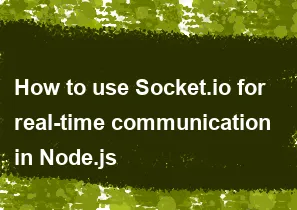How to use Socket.io for real-time communication in Node.js

Socket.io is a popular library for real-time web applications. It enables bidirectional communication between clients and servers, allowing for real-time updates and interactions. Here's a step-by-step guide on how to use Socket.io for real-time communication in a Node.js application:
Step 1: Install Socket.io
You need to install the socket.io package. Open your terminal and run:
bashnpm install socket.io
Step 2: Set Up the Server
Create a Node.js server using Express and integrate Socket.io.
javascript// server.js
const express = require('express');
const http = require('http');
const socketIO = require('socket.io');
const app = express();
const server = http.createServer(app);
const io = socketIO(server);
const PORT = process.env.PORT || 3000;
app.get('/', (req, res) => {
res.sendFile(__dirname + '/index.html');
});
io.on('connection', (socket) => {
console.log('A user connected');
// Handle events here
socket.on('disconnect', () => {
console.log('User disconnected');
});
});
server.listen(PORT, () => {
console.log(`Server is running on http://localhost:${PORT}`);
});
Step 3: Set Up the Client
Create an HTML file that includes the Socket.io client library. This file can be served by the Express server.
html<!-- index.html -->
<!DOCTYPE html>
<html lang="en">
<head>
<meta charset="UTF-8">
<meta name="viewport" content="width=device-width, initial-scale=1.0">
<title>Socket.io Example</title>
</head>
<body>
<h1>Hello, Socket.io!</h1>
<script src="/socket.io/socket.io.js"></script>
<script>
const socket = io();
// Handle events here
</script>
</body>
</html>
Step 4: Handling Events
In both the server and client, you can define custom events and handle them.
On the server side:
javascript// Inside io.on('connection', ...)
socket.on('chat message', (msg) => {
console.log('message: ' + msg);
io.emit('chat message', msg); // Broadcast the message to all connected clients
});
On the client side:
javascript// Inside the <script> tag in index.html
const messageForm = document.querySelector('form');
const messageInput = document.querySelector('#message');
messageForm.addEventListener('submit', (e) => {
e.preventDefault();
const message = messageInput.value.trim();
if (message !== '') {
socket.emit('chat message', message); // Send the message to the server
messageInput.value = '';
}
});
socket.on('chat message', (msg) => {
// Handle the received message
console.log('Received message: ' + msg);
});
Step 5: Run Your Application
Start your Node.js server:
bashnode server.js
Open your browser and navigate to http://localhost:3000. Open multiple browser tabs or windows to simulate different clients. You should see real-time communication between them.
This is a basic example, and you can extend it to meet your specific requirements. Socket.io provides a powerful and flexible API for real-time communication in Node.js applications.
-
Popular Post
- How to optimize for Google's About This Result feature for local businesses
- How to implement multi-language support in an Express.js application
- How to handle and optimize for changes in mobile search behavior
- How to handle CORS in a Node.js application
- How to use Vue.js with a UI framework (e.g., Vuetify, Element UI)
- How to configure Laravel Telescope for monitoring and profiling API requests
- How to create a command-line tool using the Commander.js library in Node.js
- How to implement code splitting in a React.js application
- How to use the AWS SDK for Node.js to interact with various AWS services
- How to use the Node.js Stream API for efficient data processing
- How to implement a cookie parser middleware in Node.js
- How to implement WebSockets for real-time communication in React
-
Latest Post
- How to implement a dynamic form with dynamic field styling based on user input in Next.js
- How to create a custom hook for handling user interactions with the browser's device motion in Next.js
- How to create a custom hook for handling user interactions with the browser's battery status in Next.js
- How to implement a dynamic form with dynamic field visibility based on user input in Next.js
- How to implement a dynamic form with real-time collaboration features in Next.js
- How to create a custom hook for handling user interactions with the browser's media devices in Next.js
- How to use the useSWRInfinite hook for paginating data with a custom loading indicator in Next.js
- How to create a custom hook for handling user interactions with the browser's network status in Next.js
- How to create a custom hook for handling user interactions with the browser's location in Next.js
- How to implement a dynamic form with multi-language support in Next.js
- How to create a custom hook for handling user interactions with the browser's ambient light sensor in Next.js
- How to use the useHover hook for creating interactive image zoom effects in Next.js